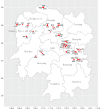Genetic diversity and differentiation of populations of Chlorops oryzae (Diptera, Chloropidae)
- PMID: 32295587
- PMCID: PMC7160969
- DOI: 10.1186/s12898-020-00293-8
Genetic diversity and differentiation of populations of Chlorops oryzae (Diptera, Chloropidae)
Abstract
Background: Chlorops oryzae is an important pest of rice crops. There have been frequent outbreaks of this pest in recent years and it has become the main rice pest in some regions. To elucidate the molecular mechanism of frequent C. oryzae outbreaks, we estimated the genetic diversity and genetic differentiation of 20 geographical populations based on a dataset of ISSR markers and COI sequences.
Results: ISSR data revealed a high level of genetic diversity among the 20 populations as measured by Shannon's information index (I), Nei's gene diversity (H), and the percentage of polymorphic bands (PPB). The mean coefficient of gene differentiation (Gst) was 0.0997, which indicates that only 9.97% genetic variation is between populations. The estimated gene flow (Nm) value was 4.5165, indicating a high level of gene flow and low, or medium, genetic differentiation among some populations. The results of a Mantel test revealed no significant correlation between genetic and geographic distance among populations, which means there is no evidence of significant genetic isolation by distance. An UPGMA (unweighted pair-group method with arithmetic averages) dendrogram based on genetic identity, did not indicate any major geographic structure for the 20 populations examined. mtDNA COI data indicates low nucleotide (0.0007) and haplotype diversity (0.36) in all populations. Fst values suggest that the 20 populations have low, or medium, levels of genetic differentiation. And the topology of a Neighbor-Joining tree suggests that there are no independent groups among the populations examined.
Conclusions: Our results suggest that C. oryzae populations have high genetic diversity at the species level. There is evidence of frequent gene flow and low, or medium, levels of genetic differentiation among some populations. There is no significant correlation between genetic and geographic distance among C. oryzae populations, and therefore no significant isolation by distance. All results are consistent with frequent gene exchange between populations, which could increase the genetic diversity, and hence, adaptability of C. oryzae, thereby promoting frequent outbreaks of this pest. Such knowledge may provide a scientific basis for predicting future outbreaks.
Keywords: Chlorops oryzae; Genetic differentiation; Genetic diversity; ISSR; Mitochondrial DNA.
Conflict of interest statement
The authors declare that they have no competing interests.
Figures





Similar articles
-
Population Genetic Structure of Chlorops oryzae (Diptera, Chloropidae) in China.Insects. 2022 Mar 25;13(4):327. doi: 10.3390/insects13040327. Insects. 2022. PMID: 35447769 Free PMC article.
-
High genetic diversity in the offshore island populations of the tephritid fruit fly Bactrocera dorsalis.BMC Ecol. 2016 Oct 13;16(1):46. doi: 10.1186/s12898-016-0101-0. BMC Ecol. 2016. PMID: 27737670 Free PMC article.
-
Genetic differentiation of geographical populations of Liriomyza sativae (Diptera: Agromyzidae) in China based on mitochondrial COI gene sequences.Mitochondrial DNA A DNA Mapp Seq Anal. 2016 Nov;27(6):3936-3940. doi: 10.3109/19401736.2014.987271. Epub 2014 Dec 9. Mitochondrial DNA A DNA Mapp Seq Anal. 2016. PMID: 25489776
-
Assessment of Genetic Diversity and Population Genetic Structure of Corylus mandshurica in China Using SSR Markers.PLoS One. 2015 Sep 10;10(9):e0137528. doi: 10.1371/journal.pone.0137528. eCollection 2015. PLoS One. 2015. PMID: 26355595 Free PMC article.
-
Genetic variation and geographic differentiation among populations of the nonmigratory agricultural pest Oedaleus infernalis (Orthoptera: Acridoidea) in China.J Insect Sci. 2015 Oct 24;15(1):150. doi: 10.1093/jisesa/iev132. Print 2015. J Insect Sci. 2015. PMID: 26496789 Free PMC article.
Cited by
-
Population Genetic Structure of Chlorops oryzae (Diptera, Chloropidae) in China.Insects. 2022 Mar 25;13(4):327. doi: 10.3390/insects13040327. Insects. 2022. PMID: 35447769 Free PMC article.
-
The complete mitogenome of Chlorops oryzae Matsumura (Diptera: Chloropidae).Mitochondrial DNA B Resour. 2021 Jun 3;6(7):1844-1846. doi: 10.1080/23802359.2021.1934171. Mitochondrial DNA B Resour. 2021. PMID: 34124364 Free PMC article.
-
Phylogenetic relationship of subterranean termite Coptotermes gestroi (Blattodea: Rhinotermitidae) inhabiting urban and natural habitats.Heliyon. 2023 Dec 14;10(1):e23692. doi: 10.1016/j.heliyon.2023.e23692. eCollection 2024 Jan 15. Heliyon. 2023. PMID: 38192757 Free PMC article.
-
EST-SSR Primer Development and Genetic Structure Analysis of Psathyrostachys juncea Nevski.Front Plant Sci. 2022 Feb 28;13:837787. doi: 10.3389/fpls.2022.837787. eCollection 2022. Front Plant Sci. 2022. PMID: 35295628 Free PMC article.
-
Genetic diversity and genetic differentiation of Megalobrama populations inferred by mitochondrial markers.Genes Genomics. 2021 Oct;43(10):1119-1132. doi: 10.1007/s13258-021-01126-8. Epub 2021 Aug 3. Genes Genomics. 2021. PMID: 34342875
References
-
- Takeda M. Genetic basis of photoperiodic control of summer and winter diapause in geographic ecotypes of the rice stem maggot, Chlorops oryzae. Entomol Exp Appl. 1998;86(1):59–70. doi: 10.1046/j.1570-7458.1998.00265.x. - DOI
-
- Takeda M, Nagata T. Photoperiodic responses during larval development and diapause of two geographic ecotypes of the rice stem maggot, Chlorops oryzae. Entomol Exp Appl. 1992;63(3):273–281. doi: 10.1111/j.1570-7458.1992.tb01584.x. - DOI
-
- Takeda M. Effects of photoperiod and temperature on larval development and summer diapause in two geographic ecotypes of the rice stem maggot, Chlorops oryzae Matsumura (Diptera: chloropidae) Appl Entomol Zool. 1997;32(1):63–74. doi: 10.1303/aez.32.63. - DOI
Publication types
MeSH terms
Substances
Grants and funding
LinkOut - more resources
Full Text Sources
Research Materials
Miscellaneous

